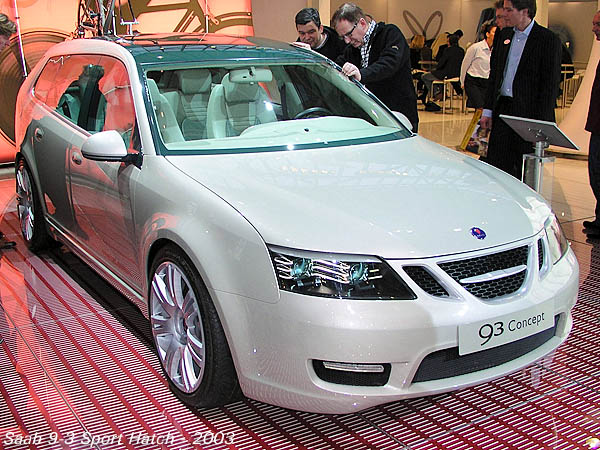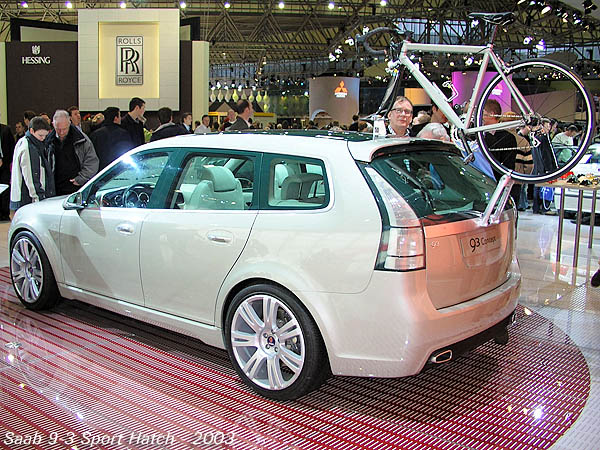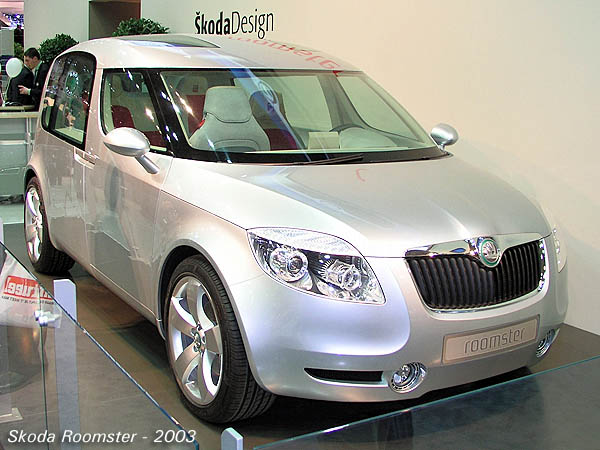|
 Saab presented its 9-3 Sport Hatch concept at the Frankfurt Motor Show in 2003 as a realistic study of how a wagon-like version of the 9-3 sedan model might look. Apparently they were very pleased with the result because in 2005 a production model was introduced looking just like it. Unfortunately this 9-3 "Sport Estate" was launched later in the year at the Geneva Motor Show so the Dutch Saab importer had to make do with displaying the concept version. Saab presented its 9-3 Sport Hatch concept at the Frankfurt Motor Show in 2003 as a realistic study of how a wagon-like version of the 9-3 sedan model might look. Apparently they were very pleased with the result because in 2005 a production model was introduced looking just like it. Unfortunately this 9-3 "Sport Estate" was launched later in the year at the Geneva Motor Show so the Dutch Saab importer had to make do with displaying the concept version.
The theory behind the Sport Hatch was that it should be a sporty cross-over between a hatchback like the old 900 model and a wagon. Of course it's aimed to appeal to those with an active outdoor lifestyle rather than the staid old family man because for some reason that's more lucrative. That it will be bought mainly by sales reps and businessmen like most Saabs is besides the point; it's the image that counts (and sells).
Anyway, to make it look more like a hatchback Saab has done away with the roof bars and came up with an construction that fits on the rear for carrying bikes and such. Funny thing is that the roof bars have become an option on the production model while the special construction on the rear has disappeared. Seems a bit silly really, deleting a traditional feature of a wagon model in order to make it look different and then offering it as an extra.
 Other exterior details include a full size glass roof (didn't make it into the production model), spoilers and skirts all round, chromed exhaust tips and big 20" alloy wheels combined with a lowered sports chassis. The interior is fitted with four sports seats of which the rear ones fold down. Other exterior details include a full size glass roof (didn't make it into the production model), spoilers and skirts all round, chromed exhaust tips and big 20" alloy wheels combined with a lowered sports chassis. The interior is fitted with four sports seats of which the rear ones fold down.
The powertrain is a 2-litre 4-cylinder turbocharged unit providing no less than 250 hp mated to a "Sentronic +2" automatic transmission driving the front wheels. This transmission has five speeds complemented with two intermediate gears, 2.5 and 3.5, which are activated on kick-down of the throttle to make overtaking even easier than the 250 horses already will. Operating the transmission can be done fully automatic or semi-manual by buttons on the steering wheel. Top speed is limited to 250 kph and 0-100 kph acceleration takes about 7 seconds.
There's no denying that the Sport Hatch is a good looking, burly car with a dynamic character. It's also a bit of a show-off and for a wagon it doesn't seem all that practical. As direct opposition for the Audi A4 and BMW 3-series 5-door models it lacks a bit of refinement and most of all a good sales pitch.
 Needing far more than a good sales pitch is this Skoda Roomster concept since it's unfortunate enough to be aesthetically challenged. It appeared in the same year and at the same show as Saab's Sport Hatch but reveals a totally different approach to styling a wagon-like car. Needing far more than a good sales pitch is this Skoda Roomster concept since it's unfortunate enough to be aesthetically challenged. It appeared in the same year and at the same show as Saab's Sport Hatch but reveals a totally different approach to styling a wagon-like car.
The name "Roomster" is apparently a contraction of the words room (obvious) and roadster (god knows why) and a production car along its lines is actually slated for introduction in 2006. Its reason for existence is to offer a whole lot of flexible, practical interior room on a modest wheelbase for the whole family. The car sits on a 2.71 meters wheelbase (at a total length of 4.1 metres) but seems larger thanks to its 1.7 metres height, which is almost as much as its width: 1.8 metres.
On the exterior there are a number of noticeable features. First off there is a new nose design which sets it apart from the current Skoda line-up. Skoda has indicated that a similar design may become the face of Skoda's production cars of the future. More remarkable is its airplane-like windshield and side windows treatment, which is different from anything in its market segment. Then there is a very large rear window which acts like a hatch, twin sunroofs and last but not least: asymmetrical sides. On the driver's side there is only one door, giving entrance to the driving position, and on the passenger's side there are two doors, for the front and the rear section. This is meant as a safety feature.
 The interior offers also some interesting features. Both front seats can be rotated to face the rear seats to create sort of a conference room. The rear seats can be slided 75 cm backwards to create more space between the two rows of seats, which should be enough to place two complete bikes diagonally in the car, through the sliding rear side door. The rear seats can also be folded down to create even more luggage space. The interior offers also some interesting features. Both front seats can be rotated to face the rear seats to create sort of a conference room. The rear seats can be slided 75 cm backwards to create more space between the two rows of seats, which should be enough to place two complete bikes diagonally in the car, through the sliding rear side door. The rear seats can also be folded down to create even more luggage space.
For the production model the strategy is to compete with established models like the Renault Scenic and the Citroen Picasso at prices reflecting a lower model class like that of the Renault Modus. It's about the same strategy which has worked for Skoda (within the VAG-concern) to a certain extent up to now, though its cars were rather of a conservative, inconspicuous nature, which can't be said for the Roomster.
It will be interesting to see how the Roomster will do in the market place. Will people like a non-conformist space-car model at a bargain price with looks which take a lot of getting used to from the Czech manufacturer, or will they pay the extra money for the established names and models? Skoda states that the appearance of the production Roomster will be revised, but a car like the Nissan Tone seems to be in with a better chance.
|
